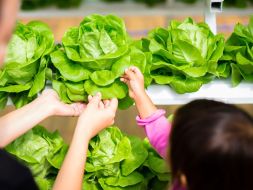Four of the Most Frequently Asked Hydroponic Gardening Questions

Do you live in a condominium without a balcony? Maybe you do have a balcony, but you do not have much floor space. You have always wanted to garden, but have never wanted to give up that precious space where your reclining lawn chair and side table fit perfectly. The best solution for you might be an indoor hydroponic garden.
What is a Hydroponic Garden?
A hydroponic garden is a garden that does not use soil. Instead, it relies on nutrient enriched water to sustain plant life. One popular variety of hydroponic garden is a hydroponic shelf unit. These are glass units that store the plants on shelves. The interior is laden with artificial light and the fact that it is contained means that there is lots of humidity to support plant growth. The nutrient enriched water is delivered to the plants via a self-contained irrigation system. The more sophisticated ones will use sensors and cameras to automatically determine when the plants need water and nutrients. This amounts to less work for the owner because it does not require constant monitoring.
Why Go Hydroponic Instead of Planting a Regular Garden?
No matter how favorable your outdoor growing conditions may be, there is always a finite growing season. With an indoor hydroponic garden, produce can be grown at any time of year. Not only will this make your yields bigger, but it also expands the breadth of foods that you can enjoy. Because you are not introducing foreign vegetation on any domestic soil, nobody can tell you what you can and cannot grow. There is also the issue of using herbicides to deal with weeds. With a hydroponic garden, weeds are nonexistent. This means that everything grown has the potential to be fully organic.
Does the Upfront Cost Pay for Itself in Lower Grocery Bills?
A top of the line hydroponic garden system designed for high yields might cost $4,000. If all you grew in the unit was basil, you could grow 6 pounds a week. One pound of organic, high end basil might cost $20. At $120 worth of basil a week, the unit would pay for itself well within one year. Most people will not want to grow just basil. A typical user might split up the yield to grow one third lettuce, one third herbs and one third greens. This would generate 8 heads of lettuce, 8 bunches of greens and 8 bundles of herbs per week. To sustain yields of this size, you would spend $100 per month in seed and nutrient packets at most. The unit might pay for itself after 4 years with this more balanced bundle.
Not all hydroponic systems require such a large upfront cost and commitment to high yields. There are many options out there in terms of yield size and cost. A couple with no children could not possibly consume 8 heads of lettuce per week. Some hydroponic garden units designed for smaller yields cost as little as $700. Most of them are designed so that the yields they produce are proportionate to the upfront cost of the unit.
Why Even Bother Growing Food at All?
We all have to shop at the local grocery store for bread, cereal and meat products anyway, so why not just get what you need from the produce section and be done with it? Using a hydroponic garden in the home generates two big benefits: it delivers the best possible quality food at a low price and it is the most sustainable way to produce and consume food.
Nothing beats the taste of freshly harvested vegetables. Food that has to travel across a continent or ocean to get to your table will have to pass through several refrigeration units along the way. Each refrigeration cycle diminishes the quality of the product. There is also an enormous carbon expenditure attached to this. What is worse is that most of the plastic that food is packaged in cannot be recycled. A household hydroponic garden eliminates all of this. If the goal of the future is to become carbon neutral and to stop littering our oceans with plastic, the way we access food will need to change.